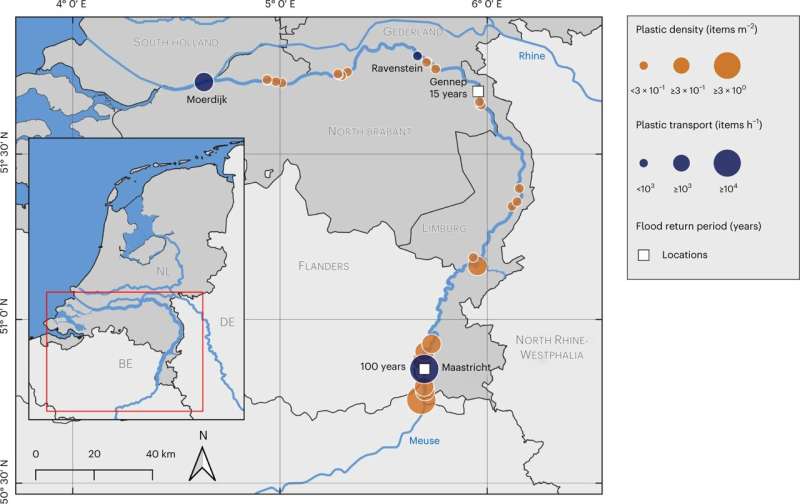This article has been reviewed according to Science X's editorial process and policies. Editors have highlighted the following attributes while ensuring the content's credibility:
fact-checked
peer-reviewed publication
trusted source
proofread
Study: River Maas contained as many as 84,000 plastic objects per hour during flood

During the 2021 flood, over one hundred times the normal volume of plastic waste was carried through the river Maas. Researchers counted up to 84,000 plastic objects per hour in the Maas. This is revealed in a publication by Wageningen hydrologists that appeared in Nature Water today. Most of the plastic was not carried to the North Sea but was deposited in the flood plains.
Prolific precipitation in Belgium, South Limburg and Germany caused floods, casualties and significant damages between 13 and 20 July 2021. The water level in the Maas was extremely high, and the river burst its banks in several locations, bringing trash with it. A unique opportunity for researcher Tim van Emmerik, who was working on measuring the amount of plastic pollution in the Dutch rivers. He increased the number of measurements along the Maas between Maastricht and Moerdijk.
To his amazement, the Maas near Maastricht carried over one hundred times its normal volume in plastic waste during the flood. Researchers recording plastic waste floating by from spots on bridges counted up to 84,000 plastic items per hour. The daily average was between 30,000 and 40,000 plastic items per hour, with a peak on 15 July. They identified the usual plastic bottles and bags, but also garden furniture, tampons, trash bins, matrasses, fridges and even a few caravans.
Van Emmerik identified three sources behind the enormous number of plastics in the river. "The flooding in the estuaries that discharge into the Maas, such as the Geul in Valkenburg, caused the water to, in a manner of speaking, sweep the streets, carrying waste bins and garden furniture to the river. Secondly, the sewers flooded, causing many sanitary wipes and tampons to end up in the river. And third: the plastic that had already been deposited into the flood plains was mobilized due to the rising water levels."
The researchers discovered that most of the plastic waste did not reach the North Sea but was deposited along the Maas. Van Emmerik says, "We also counted the plastic waste in Ravenstein, one hundred kilometers above Maastricht. Here, the stream of waste was six times the normal volume but still 90-94% less than in Maastricht. According to our data recorded on the banks, almost all of the plastic remained behind in plants and shrubs in the flood plains, particularly between Maastricht and Venlo."
The Maas is normally already considered a polluted river in Europe, but during the floods of 2021, it was just as polluted as the notoriously polluted rivers in Asia.
To reduce plastic pollution during floods, the researcher recommends carefully considering where terraces and waste bins are located in flood-sensitive areas.
The researchers conclude that floods may increase the spread of plastic waste, but the effects are local. Their study provides new insights for environmental scientists. The data will help scientists improve their global estimates of the transportation of plastic waste into the oceans and provide a better understanding of how plastic spreads in rivers.
More information: van Emmerik, T.H.M., Frings, R.M., Schreyers, L.J. et al. River plastic transport and deposition amplified by extreme flood. Nature Water (2023). DOI: 10.1038/s44221-023-00092-7. www.nature.com/articles/s44221-023-00092-7
Journal information: Nature Water
Provided by Wageningen University



















